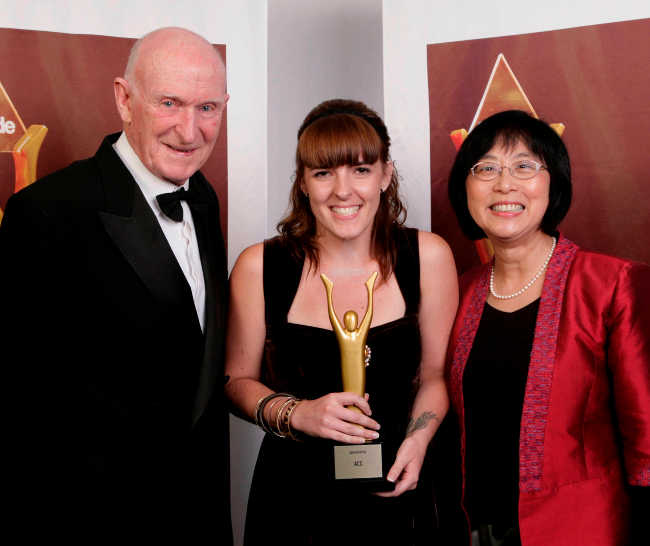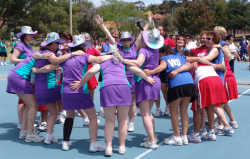Part 1 Dorothy – 14/04/03
Old Girls who attended Christchurch Girls High School in 1944-6 were amazed and angered when they read in Auto da Fay Fay Weldon’s portrayal of the school in the years when she was a pupil there. They were also very displeased when the magazine, New Zealand Listener, chose to publish that section with real names replacing the fictitious names used in the book.
When at the 125th Anniversary Celebration Fay Weldon’s description of the school was read as a credible picture of the school in the 1940s many Old Girls were even more disappointed.
Among other negative comments Fay describes the school as “a deeply serious and miserable place ….. which shook with every tremor”, “an uneasy place”, “with “panelled walls redolent with some kind of doom” where “few of the teachers smiled.” She writes of “the undisclosed, misunderstood, unexpressed and guilty passions we Christchurch schoolgirls felt for one another which, festering, somehow got into the walls and blocked the good light of common sense from the windows.”
|
|
| Christchurch Girls’ High School Building. |
Nancy Scoones (née Fordyce) expressed concern about the Listener’s publication of her real name Nancy wrote the following letter to the Editor of the Listener
345 Anakiwa Road Anakiwa Picton R D 1 Marlborough Sounds 18 September 2002
The Editor The Listener P O Box 90119 Auckland Mail Centre AUCKLAND
Sir, On 18 May this year you published in The Listener an “exclusive extract” from Fay Weldon’s latest book, “Auto Da Fay”. At the time it was drawn to my attention that my former name appeared in the text, and further perusal of your publication proved this to be so. However, I recently checked the relevant text in Weldon’s book, only to find the name Alison Grey substituted for my name, and Molly Banks for that of Nancy Bell, also a pupil at Christchurch Girls’ High School, and a close school friend of Fay (then) Birkinshaw.
I wish an explanation as to how my name got into the Listener article, and who authorised the change from the original text. I remember Fay Birkinshaw, but not quite in the context she writes. I wonder whether her sad, unpleasant memories of Girls’ High School have in some way coloured her judgment of other aspects of her schooling there. Had you done me the courtesy of asking if I minded my name being published, I would have considered it in the light of what Weldon wrote, and would probably not have agreed. I remember her as an overweight, intelligent girl, good at drama. Some of the senior girls knew that she was coping with the trauma of her parents’ divorce. As to the pair of shoes? – I well remember them, but the dress code of Girls’ High School was such that one would never have dared wear other than the regulation lace-ups.
I doubt that I ever said to Weldon the words she ascribes to me, or that I was aware of the attitude she said she had. Of course she and Nancy Bell were noticed, more for their size I think, and the fact that they seemed to be inseparable.
I find Weldon’s coverage of her Girls’ High School days rather sad, pathetic and tinged with a sort of private mal du siècle. I understand that the buildings in Cranmer Square still stand – perhaps their demolition is wishful thinking on Weldon’s part? Certainly the prevailing “system” would not have condoned or encouraged any pupil having a “crush” on another. Believe it or not, we were there to be educated, and the majority of us were. Even if Weldon feels that she, in so many ways, did not benefit from her years at Girls’ High School, I owe a reasonably successful career in languages and music at Canterbury University College to the teaching I received at that school. Weldon’s sad and somewhat morbid recollections in no way mirror my own experiences.
It is rather late for the Listener to offer an apology or a retraction, but I do insist on an explanation as to how my name – unpublished in Weldon’s book – appeared in your earlier article.
Yours faithfully (N M Scoones née Fordyce)
To this letter Nancy Scoones has received no reply from The Listener.
Most Old Girls’ views a contrast to Fay’s How different from Fay’s were the mainly happy memories recorded by those who have contributed to this article! The school was very different from Christchurch Girls’ High School today, but we believe that the school in any period should be viewed in the light of the educational climate of the time, not judged against the educational theories held as valid more than half a century later.
Nancy Scoones remembers In 2003 Nancy Scoones (née Fordyce) wrote the following article for forwarding to Girls’ High School and for publication in NZine.
“I came to Christchurch Girls’ High School after two years at boarding school in the North Island, my father having been appointed to the Headmaster’s position at Sumner School. We lived at 25 Papanui Road where there is now a liquor store (which would have upset my mother greatly, she being a strict advocate of temperance!) I spent three enjoyable years at the school before university.
My first few days at Girls’ High were spent in being assigned to a form, an interview with Miss Samuel and Miss Bone and generally marvelling at what seemed to me to be a very authoritarian regime. No talking in the corridors. Walk in single file. Never use the front door. And on no account be seen with your hand on the stair rail. I had come from a much more relaxed environment, where many of the rules were there to be broken.
“Fifth form brought me back to reality, with a test of French verbs under the watchful eye of Dorothy Bone. She was to all intents and purposes a bit of a martinet but if you did the work, performed reasonably well, paid attention and aimed for a reasonable French accent, you could get along with her. She had an accent which I am sure Chaucer would have called “Stratford-atte-Christchurch”.
“For Latin we had Ethel M Duff, a rather craggy-looking woman, but one who loved her work, and with her odd mannerisms of speech rather endeared herself to her classes. We studied Roman History from a dingy purple-covered book, written by someone (I think) called Bryant. (Does anyone remember?) On one occasion in the sixth form we were reading somewhat drearily about the Carthaginian wars, and probably wishing that the afternoon would soon come to an end – it was Friday that was reserved for Roman History. Each of us took a turn reading roughly a paragraph. Suddenly “Duffer” as we fondly called her, smote her forehead with her open hand, looked up at us and said, “I’m all of a daze – which side are we on?”. The class erupted and Duffer with it. She smiled and let the laughter continue. It was a fine end to a week! On another occasion in Lower Sixth, we were studying Virgil’s Eclogues – those wonderful poems describing the joys of rustic life, and man’s good fortune in country living; as part of the lesson, Miss Duff explained to us that it was useless trying to put Latin poetry into English verse form. The following weekend I burned the midnight oil translating one of the eclogues into rhymed couplets for the following week. No problem in volunteering to translate! At the end of the poem, Duffer pronounced in her deep voice “Ahhhhhh – goooooood, Very goooooood” (It really sounded like that!) She was a solemn person, but I suspect it hid a dry sense of humour.
“Sixth form English was a wonderful experience with Magdalen Hall guiding us through Shakespeare’s complexities – she had such a tragic look at times, and a story did the rounds that she was engaged to Rupert Brooke. I believe she did not have a degree, but her teaching was absolutely inspired and her talent for drama was indeed Girls’ High’s good fortune.
|
|
“Mathematics was my bête noire throughout most of my schooldays. For a start I could never see the sense in theorems – If Euclid had already found the answers, why should we have to try? The one year I came into my own was my sixth form year, with Clarissa Tyndall as teacher. I suspect that the mysteries of mathematics were revealed to many others as well – Miss Tyndall had such patience and teaching ability and never moved on until she was satisfied that everyone understood. We also had her for Physics, all of us starting from scratch. Later when I came to do the acoustics paper for a music degree, I was really well-grounded for the section on sound-waves having covered the theory with Miss Tyndall. However, maths took a dive in Upper Sixth, with Irene Milnes, a brilliant maths graduate but not great at imparting it to struggling pupils. She could be quite vitriolic in her delivery, and of all the teachers I had, I remember her with the least gratitude or affection.
“Betty Waller (French) and Vera (Bunny) Hooper took us for French and Latin respectively in Upper Sixth. Miss Waller was always smiling, almost simpering, and Miss Hooper was a mild-mannered pale-coloured personality. I suppose they were all in their way fairly competent teachers, but the system was such that the great gap between secondary school and university was barely bridged, and when most of us went on to Canterbury University College we were on our own.
“I have left the music bit till last. I had had two good years at my previous school in both piano and voice studies, and was somewhat amazed when Victor Peters asked the assembled classes if Nancy Fordyce was present. Eventually I sang Cherry Ripe, after it turned out that my previous music teacher had written to Mr Peters. From then on I lived for and loved every aspect of music – Victor Peters was an amazing man, carrying a war wound from years past which often laid him low, and made conducting an ordeal. He was an inspired teacher, and both the Boys’ High and Girls’ High choirs provided up-and-coming members for the Christchurch Harmonic Society. He gave us all an appreciation of wonderful choral music and taught us voice production so that we did justice to an amazing range of works. His tenors and basses often went on to join the Christchurch Liedertaafel.
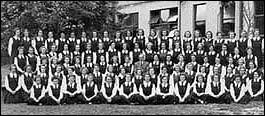
|
| Christchurch Girls’ High School Choir – 1946 Nancy Fordyce is sitting on Mr Peters’ right, and Fay Birkinshaw is fourth from the right in the back row Click here for a larger version |
“The school motto Ergo tua rura manebunt – Therefore your fields shall remain yours – comes from one of Virgil’s Eclogues. I think the “fields” are perhaps the fields of knowledge which it is hoped will take us on through life and will remain as our basis for further learning.
For me, recollecting people, places and events sixty years ago, I have few if any negative memories. It was an age where teachers had private lives never divulged to pupils; school rules were there to be obeyed – you toed the line or took the penalty for not doing so; we were there to learn and be educated, not exactly for life, but certainly for the next phase in our existence. Had I not attended Girls’ High, I know I could never have attempted university study.
“As you will see from my letter to the Listener, I found the extract from Fay Weldon’s book “Auto da Fay” sad, pathetic, and slightly sick. As a 14-15 year old, she was having a fairly torrid time dealing with her parents’ separation and eventual divorce. I imagine her sister Jane was equally affected, but was a more reserved person. I do not seek to excuse Weldon, but it is obvious that her teenage memories are overlaid with emotions and opinions gained in later life – a happy marriage which ended in a bitter divorce.”

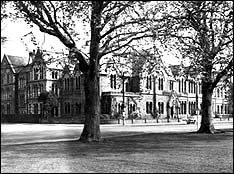
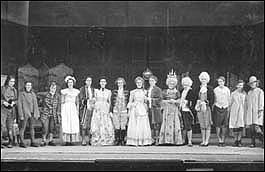 The cast of Miss Hall’s production of She
The cast of Miss Hall’s production of She
